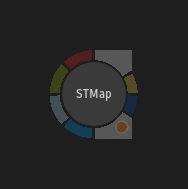STMap
Use the STMap node to either undistort or distort a clip by means of an STMap clip. This STMap clip can originate from another application or from the STMap or Inverse STMap outputs of a Lens Distortion node. In the latter instance, the STMap node is applied to either undistort a different clip or to reintroduce distortion to a clip previously undistorted using the Lens Distortion node.

| Access | To access the STMap menu, use:
|
| Inputs |
|
| Outputs |
|
The Front and STMap inputs must have an incoming connection for the node to yield a result.
Clips connected to the Front, Constraint, and Matte inputs must have the same resolution. The STMap input can have a different resolution.
The resolution of the output clips differs based on the selected Framing mode:
- The resolution is inherited from the STMap input when Entire Front Frame or Use STMap to Front Ratio is selected.
- The resolution is set by the Display Window information when Use Data & Display Window is selected.
Settings

Framing
Framing option
Select which region of the Front clip is used.
| Select: | To: |
|---|---|
| Use Entire Front Frame | Sample pixels from the first pixel at the bottom left of the Front clip (0,0) to the last pixel at the top-right (1,1). This mode should be used when:
|
| Use STMap to Front Ratio | Apply a scaling on the Front with a STMap/Front ratio. This result is a Front that is padded or zoomed. This mode should be used when:
|
| Use Data & Display Windows | Use Data and Display Windows information from the STMap. This option should be used when the STMap OpenEXR clip contains this information. |
Data / Display Windows option
Select whether the Data / Display Windows information is fetched from an OpenEXR clip connected to the STMap input or are manually set.
The From STMap option works only if a clip is directly connected. This won't work if a node other than a clip is connected. In that case, you can propagate the information utilising the Paste Special workflow.
Data / Display Windows
The Data and Display Windows controls are only available when the Framing mode is set to Use Data / Display Windows.
Not every STMap clip holds this information, but certain applications, including The Foundry's Nuke, are capable of exporting them.
An STMap generated from the Lens Distortion node, however, does not include this information.
Offset
Using the X and Y Offset controls can be faster than adjusting the Data and Display windows controls when there are minor tweaks required to fix differences between images.
Repeat Mode
Repeat option
Determine if the part of the image where no pixels appear remain as-is or is filled.
| Select | To |
|---|---|
| Repeat Off | Have parts of the image where no pixels appear remain black. This is the default option. |
| Mirror Repeat | Mirror pixels to fill the black parts. |
| Tile Repeat | Tile pixels to fill the black parts. |
| Repeat Last | Repeat the last pixels up to the edge of the clip to fill the black parts. |
Filter
Filter option
Apply filtering to the pixels that moved in the image. Pixels outside the white parts in the clip connected to the Constraint input are not filtered.
| Filter | Result |
|---|---|
| Nearest | No filtering is applied. The pixel of the texture closest to the screen pixel is displayed. |
| Linear | Basic bilinear filtering. |
| Mitchell-Netravali | Bicubic reconstruction filter designed to minimize reconstruction artifacts. This is the default option. |
| Catmull-Rom | Bicubic reconstruction filter exhibiting a reasonably sharp frequency response. |
| Anisotropic | Non-proportional filtering between X and Y (faster to process than EWA). |
| Aniso + Linear | A combination of Anisotropic and Linear filtering. |
| EWA | A high-quality elliptical weighted average filter that determines the proportions of an elliptical area around every pixel to perform a weighted sampling of the colours (slower to process than other filters). |
| EWA + Linear | A combination of EWA and Linear filtering. |
